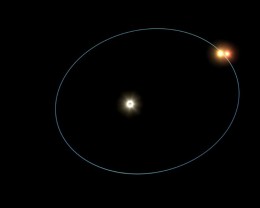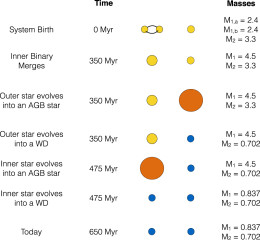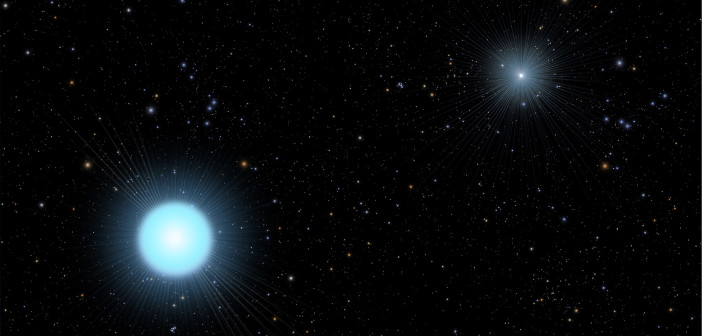A new study has examined how the puzzling wide binary system HS 2220+2146 — which consists of two white dwarfs orbiting each other — might have formed. This system may be an example of a new evolutionary pathway for wide white-dwarf binaries.
Evolution of a Binary
More than 100 stellar systems have been discovered consisting of two white dwarfs in a wide orbit around each other. How do these binaries form? In the traditional picture, the system begins as a binary consisting of two main-sequence stars. Due to the large separation between the stars, the stars evolve independently, each passing through the main-sequence and giant branches and ending their lives as white dwarfs.

An illustration of a hierarchical triple star system, in which two stars orbit each other, and a third star orbits the pair. [NASA/JPL-Caltech]
But in the case of the double-white-dwarf binary HS 2220+2146, the opposite is true: the more massive of the two white dwarfs appears to be the younger and hotter of the pair. If it wasn’t created in the traditional way, then how did this system form?
Two From Three?
Led by Jeff Andrews (Foundation for Research and Technology-Hellas, Greece and Columbia University), a team of scientists recently examined this system more carefully, analyzing its spectra to confirm our understanding of the white dwarfs’ temperatures and masses.
Based on their observations, Andrews and collaborators determined that there are no hidden additional companions that could have caused the unusual evolution of this system. Instead, the team proposed that this unusual binary might be an example of an evolutionary channel that involves three stars.

The authors’ proposed formation scenario for H220+2146. In this picture, the inner binary merges to form a blue straggler. This star and the remaining main-sequence star then evolve independently into white dwarfs, forming the system observed today. [Andrews et al. 2016]
An Early Merger
In the model the authors propose for HS 2220+2146, the binary system began as a hierarchical triple system of main-sequence stars. The innermost binary then merged to form a large star known as a “blue straggler” — a star that, due to the merger, will evolve more slowly than its larger mass implies it should.
The blue straggler and the remaining main-sequence star, still in a wide orbit, then continued to evolve independently of each other. The smaller star ended its main-sequence lifetime and became a white dwarf first, followed by the more massive but slowly evolving blue straggler — thus forming the system we observe today.
If the authors’ model is correct, then HS 2220+2146 would be the first binary double white dwarf known to have formed through this channel. ESA’s Gaia mission, currently underway, is expected to discover up to a million new white dwarfs, many of which will likely be in wide binary systems. Among these, we may well find many other systems like HS 2220+2146 that formed in the same way.
Citation
Jeff J. Andrews et al 2016 ApJ 828 38. doi:10.3847/0004-637X/828/1/38

4 Comments
Pingback: wide WD binary with an unusual history
Pingback: Astronomia: scoperto un sistema binario insolito, in origine avrebbe coinvolto tre stelle - Meteo Web
Pingback: Un duetto stellare insolito – La Macchina del Tempo
Pingback: Un misterioso sistema binario | Accademia delle Stelle